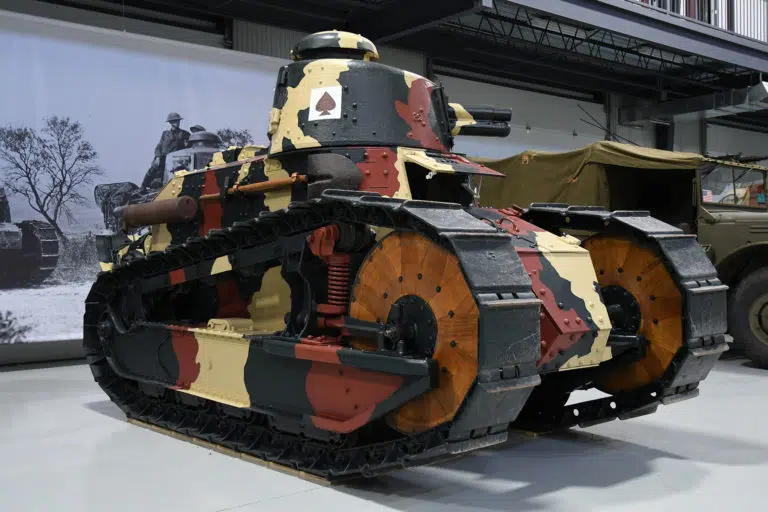
WWI FT-17
Crew: 2
Main Armament: Puteaux SA 1918 37mm or 8mm Hotchkiss Machine Gun
Engine: Renault 4 cyl.
Horsepower: 39
Weight: 7.2 tons
Width: 5’9” (1.74 m)
Height: 7’0” (2.14 m)
FT Renault is known for revolutionizing tank warfare. The first light tank of its time, the FT Renault, was easier to manufacture, cheaper, and more agile than the heavy and largely immobile tanks of the time. The FTs, although lighter in armor, could be produced in mass, and thus relied on “swarm” tactics to overwhelm its entrenched enemies. Louis Renault of Renault Automobile Company originally produced the FT Renault, but eventually, demand for this tank was so high that it was outsourced to other automobile companies around France and even some U.S companies. The FT had great success in WWI and is widely regarded as the world’s “first modern tank” as it inspired the design of many of the tanks we know today.
The FT Renault was produced in mass numbers from 1917 to 1918. The first 84 were delivered prior to the end of 1917 and 2697 more delivered over time until November 1917. The FT was so effective that towards the end of the war, that Renault could not keep up with the demand for the tank, therefore production had to be outsourced to other companies in France. Even the US received blueprints and created 1200 of its own to support French and US forces. The FT Renault featured Renault 4-cylinder air-cool petrol engine that was located at the rear of the tank, along with a modified Holt Chassis that provided better mobility over difficult terrains. A tail was added to the end of the Renault to stabilize the vehicle and prevent the rear end of the tank from falling in when passing over a trench. The FT Renault also featured a turret that was armed with either a Puteaux SA 18 37 mm short-barreled gun or a coaxial Hotchkiss 7.92mm machine gun. The FTs armed with the Puteaux SA 18 37 mm were referred to as the “male” version while the FTs equipped with the coaxial Hotchkiss 7.92mm machine gun were referred to as “female.”
The first FTs were deployed to the 1st BCL (Batallion de Chars Légers), and the FT saw its first action in May 1918 at Foret de Retz. The FTs were also used in the Second Battle of Marne, Saint-Mihiel and Meuse-Argonne Offensives in WWI. The FTs were widely effective despite their light armor. Their improved maneuverability and narrow stature allowed them to tread through No Man’s Land without being hit as well as escort the French troops in cover behind them to enemy trenches. They were deployed in mass and were capable of overrunning entrenched German forces. The turret also proved very valuable in battle as it provided a 360-degree range of fire when the Renault would clear out trenches. The FT was used in 4356 engagements in WWI, with a total of 746 FTs lost in battle. After WWI, the FTs were shipped to countries worldwide. Some FTs remained in action in French, Polish, Yugoslavian, and Greek lines in WWII despite being vastly outmatched by German Panzers. A tank ahead of its time, the FT Renault paved the way for the development of the modern tanks we know today.
